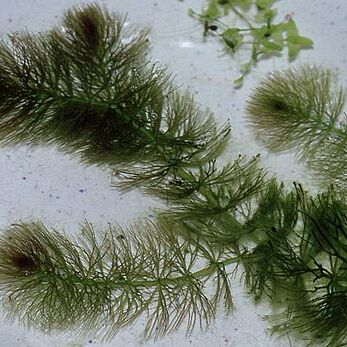Submerged aquatic herbs, usually free floating, monoecious; roots absent. Leaves in whorls; lamina 1 or more times dichotomously branched, with linear segments. Flowers 1 or more per node, male and female at separate nodes. Perianth of 8–13 herbaceous lobes, united at base; each margin often with a single spine; lobe apex truncate, with 2 lateral spines and a central projection. Male flowers: subsessile; stamens numerous in several whorls on domed torus around sterile pistil; anthers ± sessile, bilocular, dehiscing longitudinally, with connective produced apically into 2 spines, margins often with 1–3 spines, immature anthers resemble perianth lobes, at maturity the tissues become gas filled and anthers detach and rise to water surface where they dehisce and pollen sinks into female flowers below. Female flowers: sessile or shortly pedunculate; staminodes absent; ovary superior, sessile, tapering into long style, 1-locular; ovule 1, pendulous. Fruit a hard nut, often winged on margin, often with basal pair of prominent spines; style persistent and spinose. Seed pendulous, endocarp absent.
Herbs perennial, submersed, hydrophilous, monoecious. Roots absent. Stems glabrous, branched, free or attached by slender shoots. Stipules absent. Leaves cauline, 3--11 in a whorl; petiole inconspicuous; leaf blade divided dichotomously into filiform segments; segments with 2 rows of denticles. Inflorescences reduced, solitary or with vestigial branches, 1-several at a node, extra-axillary, alternating with leaves, sessile or peduncles lengthening in fruit; involucre of 8--15 foliaceous bracts; bracts 1.5--2 mm, apex terminated by 2 denticles and a medial multicellular appendage. Flowers naked, subsessile. Staminate flower: stamens 3--50, spiral; filaments short; anthers 2-celled, dehiscing by longitudinal slits. Pistillate flower: pistil 1, simple; ovary 1-loculed, placentation laminar; ovule 1, pendulous; style persistent, short or elongate; stigma decurrent. Achene leathery, indehiscent, ellipsoid, smooth or tuberculate, basal spines 0--2, facial spines 0--2, marginal wing present or absent, marginal spines 1--8. Seed 1, unitegmic, endosperm and perisperm absent; cotyledons fleshy.
Herbs perennial, aquatic, without rhizomes; roots absent; air chambers conspicuous. Leaves arising from branched stems, sessile, whorled; stipules absent. Leaf blade undivided to finely dissected, margins serrulate, laticifers absent; 1st leaves of plumule simple or forked. Inflorescences axillary, solitary flowers. Flowers unisexual, staminate and pistillate on same plant, submersed, sessile or nearly so, subtended by involucre of 8-15 linear bracts; perianth absent; stamens 3-50; anthers nearly sessile, dehiscing by longitudinal slits, connective prolonged; pistil 1, simple; ovary 1-locular; placentation laminar; ovule 1; style elongate; stigma decurrent. Fruits achenes, indehiscent. Seed 1, aril absent; endosperm and perisperm absent; embryo well developed; cotyledons 2, fleshy.
Male flowers subsessile; stamens up to c. 30 in several whorls on a domed torus around the pistillode; filaments short or absent; anthers oblong, extrorse, 2-locular, dehiscing longitudinally, connective produced apically into 2 spines and a central projection as in perianth lobes, immature anthers resembling perianth lobes, margins 1–3 spined; mature anthers detach and float to the water-surface where they dehisce and shed pollen on to plants below
Leaves in whorls, filiform, once or more dichotomously branched, margins ± spinose-dentate; apical segments truncate, 2-spined at the apex with a reddish glandular projection between the spines (basal segments sometimes parasitised, becoming swollen and sac-like)
Flowers axillary, 1-several per node, male and female flowers at different nodes, ± sessile; perianth lobes 6–13, united at the base, strap-shaped or obovate, margin often with a single lateral hyaline spine or ± lacerate, apex as for leaf apex
Male flowers: stamens 10–22, crowded on a flat torus; anthers almost sessile, erect, linear-oblong, 2-celled, cells parallel, opening lengthwise; connective produced beyond the cells, thick and often coloured
Seed pendulous; endosperm 0; embryo straight; cotyledons oblong, equal; radicle very short, the plumule already well developed and showing several leaves in the seed
Female flowers sessile or shortly pedicellate; staminodes absent; ovary superior, sessile, ovoid, tapering into a long style; ovule 1, pendulous
Calyx thinly herbaceous, many-parted into narrow subvalvate segments often dentate or lacerate at the apex
Female flowers: staminodes 0; ovary sessile, ovoid, 1-celled; style continuous with the ovary
Fruit a nut, ovoid or ellipsoid, often warty and basally-spined, style ± persistent, spinose
Flowers monoecious, solitary in the whorls, the males and females at separate nodes, sessile
Submerged aquatic, branching, usually rootless herbs, perennating by buds, monoecious
Leaves verticillate, variously divided with thread-like or linear segments
Aquatic submerged herbs with leafy floating branches
Embryo straight, endosperm absent
Fruit a nut, ovoid or ellipsoid
Ovule 1, pendulous

